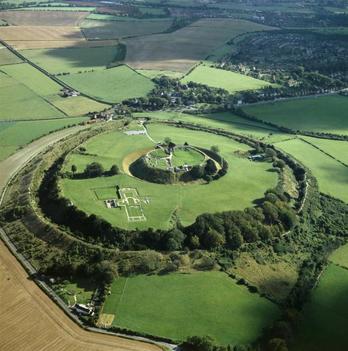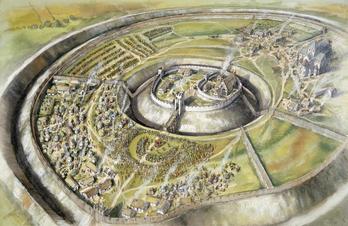Old Sarum hillFort
An important stop on the itinerary of the thousands of tourists who flock to the Salisbury area every year is the windswept site of the original city at Old Sarum, and it would be no surprise if some of these visitors feel somewhat disappointed at what they find and seek solace in the 'Old Castle Inn' which is conveniently situated immediately opposite the object of their pilgrimage.
Old Sarum is exactly what it appears to be, a rather large and desolate hill fort, yet it has, in its chequered past, played an important part in the shaping of British history, with effects felt as far away as Western Europe. It is uncertain which ancient tribe was the first to annex this natural vantage point as a settlement, but is generally agreed that, well before the
 beginning of the first century AD, Iron Age man occupied the site, exploiting in full its potentialities of good visibility and elevated position, which meant he was within sight of other similar camps, such as those at Badbury and Yarnbury. Subsequent occupants included the Celts, who were alleged to have named the fort 'Caer Saflog', or Citadel of the Service Tree, which has been taken to mean the Whitebeam that thrives in chalky soil and, later, the Romans, who translated the name as Sorviodunum. They, however, preferred to construct their settlement a little further down towards the river, probably in what we now know as Stratford-sub-Castle. Several Roman roads can be traced from this area, radiating to Badbury Rings, Dorchester, Winchester, the Mendip lead mines in Somerset and, finally, there is Port Way, which still runs north-eastwards to Silchester and carries modern motor traffic, although Silchester is no longer the important settlement that it was in those days. beginning of the first century AD, Iron Age man occupied the site, exploiting in full its potentialities of good visibility and elevated position, which meant he was within sight of other similar camps, such as those at Badbury and Yarnbury. Subsequent occupants included the Celts, who were alleged to have named the fort 'Caer Saflog', or Citadel of the Service Tree, which has been taken to mean the Whitebeam that thrives in chalky soil and, later, the Romans, who translated the name as Sorviodunum. They, however, preferred to construct their settlement a little further down towards the river, probably in what we now know as Stratford-sub-Castle. Several Roman roads can be traced from this area, radiating to Badbury Rings, Dorchester, Winchester, the Mendip lead mines in Somerset and, finally, there is Port Way, which still runs north-eastwards to Silchester and carries modern motor traffic, although Silchester is no longer the important settlement that it was in those days.
In AD552, Saxons arrived on the scene after ousting the occupying Britons. The name now became Saerburh (place of battle) and they proceeded to unite their southern kingdoms to form Wessex, with a capital at Wilton and Old Sarum was now important enough to start minting its own coinage. The Normans arrived shortly after their success at Hastings in 1066, fortified the hill and built a timber castle, later reinforced with stone. It was decreed by the new King William that a cathedral should also be built at the fort, which now became Sarisberie so, in 1075, Bishop Hermann moved the See of Sherborne, which covered a large part of Southern England, to Sarisberie and built a cathedral in a style rather reminiscent of his Rhineland home.
On the death of Hermann, the cathedral was completed by Bishop Osmund in 1092 and it was he who inaugurated the 'Sarum Use', which was employed for various rites and procedures in church services in many parts of Europe. Unfortunately, almost as soon as the building was finished, it was struck by lightning, partially destroyed and had to be rebuilt.
Osmund died in 1099, but it was 1457 before he was made patron saint of Salisbury. Around 1087, William the Conqueror ordered all British noblemen to travel to Old Sarum to acknowledge the fact that he was King and the growing population now expanded outside the wall. The decline of the city was accelerated in the 12th Century when Bishop Roger, an opportunist and empire-builder, reconstructed the cathedral inside the bailey in a vain attempt to solicit the protection of the military against increasing unrest between populace, clergy and garrison.
Old Sarum was seized by King Stephen in 1139 and the bishopric eventually taken over by the Poore brothers, who, faced with the continuing disenchantment of the community, applied to the Pope for permission to move the cathedral to a more suitable place, listing many problems ranging from the reasonable (lack of an adequate water supply, services inaudible to worshippers because of constant high winds) to the ridiculous (chalk glare caused blindness). Old Sarum had obviously outgrown its isolated position and their request was sanctioned, so the Poores asked the Abbess of Wilton for a donation of land on which to build New Sarum, but the Abbess refused and they turned their sights southwards, selected the water meadows of Salisbury and thus, presumably, fuelled the growing animosity between Wilton and the City.
By 1258 the splendid new cathedral was complete and Old Sarum, for the first time in hundreds of years, returned to its previous solitude, while Salisbury henceforward became known as New Sarum for all municipal purposes.
In the 14th Century, stones were removed from the hilltop to provide walls for the new Cathedral Close and some of these are still in position today, while a further indignity for Old Sarum was its use as a prison for Salisbury's wrongdoers!
The ultimate depth of shame was, however, reached when Old Sarum became one of the 'Rotten Boroughs' with zero population that could be bought and sold to enable ambitious politicians to enter Parliament and Prime Minister William Pitt reached his position by this means, as records show that his family sold Old Sarum for £65,000 in 1805. The old elm under which MPs were elected became known as the 'Parliament Tree' and it seems fitting that this tree was blown down in a storm shortly after the Reform Act of 1832 had put a long overdue stop to the Rotten Borough system. Today a plaque now stands where the tree once stood.
Old Sarum, with the remains of its ancient buildings, now broods in splendid isolation, except for the steady stream of tourists in the summer who gaze at the hill fort that became a city of national importance and then fell from grace.
DOWNLOAD PROPERY BROCHURE
|